
Catalog excerpts
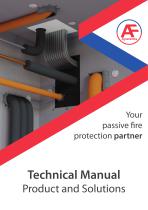
Your passive fire protection partner Technical Manual
Open the catalog to page 1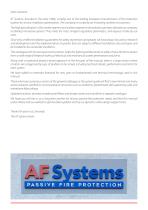
Dear customer, AF Systems, founded in the early 1990s, is today one of the leading European manufacturers of fire protection systems for service installation penetrations. The company is trusted by an increasing number of customers. The high specialisation in this market segment and a direct experience of worksite issues have allowed our company to develop innovative systems. They meet the most stringent regulatory parameters, and requests made by our users. Since only certified installation guarantees the safety of premises and people, we have always focused on research and development and...
Open the catalog to page 5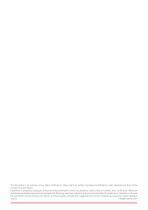
The document is an overview of our latest certifications. There might be further innovations/certifications under development that will be included in a later reprint. Experience in preparing catalogues and technical documentation shows that, despite a careful check of numbers, texts, certification references and dimensional data, some errors are possible. The following sheets are indicative and we recommend that the application method is confirmed. We would like to thank all those who inform us of inaccuracies and help with suggestions for a more complete, accurate and correct catalogue...
Open the catalog to page 6
(1) Fuels are substances which react with oxygen (or another oxidiser). They can be classified according to their physical state, differentiating into solid, liquid and gaseous fuels, and produce thermal energy following a combustion reaction. A fundamental feature of each fuel is its calorific value, i.e. the maximum energy that can be obtained from the complete combustion of a unit of fuel under standard conditions. Each material has a temperature above which it continues to burn and below which it tends to burn out - the ignition temperature. (2) Oxidisers are substances capable of...
Open the catalog to page 7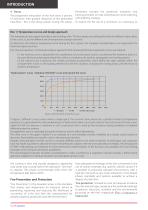
INTRODUCTION 4 - Decay The progressive exhaustion of the fuel starts a process of extinction with gradual reduction of the generated heat flow - this is the decay phase. During this phase, Prevention includes fire protection measures, and training activities on risks and behaviour when planning a fire-fighting strategy. To reduce the fire risk to a minimum, it is necessary to Box 1 | Temperature curves and design approach The temperature-time graph describes a trend during a fire. The four phases are distinguished by the different slope values of the curve, i.e. by the different rate of...
Open the catalog to page 8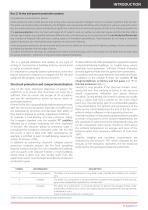
INTRODUCTION Box 2 | Active and passive protection systems Fire protection can be active or passive. Active protection tools include devices that, during a fire, need an external "intelligent" action or impulse to perform their function. This action can be personally controlled (e.g. the firefighter who extinguishes the flames with a hydrant) or using an automatic system (e.g. the smoke extraction system activated by a signal from a detection unit) which extinguishes the fire in the shortest possible time. The passive protection tools, the heart and engine of AF Systems' work, act without...
Open the catalog to page 9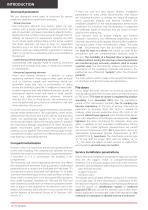
INTRODUCTION Structural protection We can distinguish three types of structures for passive protection objectives classification purposes: - Simple structures Non-continuous elements (e.g. beams, pillars, tie rods, chains), with a purely mechanical support function. The lack of a partition role makes it possible to identify the firefighting function of these structures only through their "R" stability. To measure this requirement correctly, the tests must include loads representative of the actual weights that these elements will have to bear. For suspended elements (e.g. a tie rod) we...
Open the catalog to page 10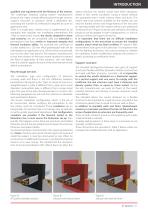
INTRODUCTION qualified and registered with the Ministry of the Interior. This challenges fireproof sealing system manufacturers because any major change affecting pass-through services, support structures or products needs a dedicated test, increasing the number of certifications required to cover an application area. There is a single basic criterion that is implemented by all standards that regulate the installation penetrations (EN 1366) to extend test results: the results obtained in worst case scenarios can be considered valid and extended to penetrations that have similar or improved...
Open the catalog to page 11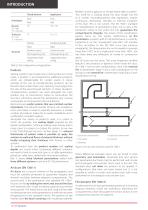
INTRODUCTION Tested element Orientation Sandwich panel Sandwich panel Self-supporting wall Self-supporting wall Independent false ceiling Independent false ceiling ("d" = test; "D" = real case) ("s" = test; "S" = real case) Table 2 | Test configuration and application Products Sealing systems may include one or more products. In most cases, a product is accompanied by additional products, which are indispensable for certain results. A classic example of the use of complementary products can be found in cases where there is an opening, much larger than the size of the pass-through element....
Open the catalog to page 12
INTRODUCTION Box 3 | The most efficient system for EI 120 sealing Figure 4a | Sealing depth 120 mm Figure 4b | Sealing depth 320 mm Figure 4c | Sealing depth 600 mm The first system, our "base case", uses certified AF Bags with the "short" side of 120 mm arranged parallel to the structure's thickness; the longer side of 300 mm is available to occlude the penetration section. The number of units required to seal the opening is optimised accordingly. Since it has not been used in testing, it is not necessary to provide an external frame to validate the installation based on the certification....
Open the catalog to page 13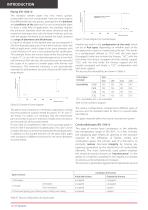
INTRODUCTION Piping (EN 1366-3) The standard divides pipes into two macro groups: combustible and non-combustible. Here are some aspects that differentiate the two groups, starting from the diameter and conditions of the pipe end. For non-combustible pipes to have a valid field of application, the standard requires the minimum diameter (with the lesser thickness) and the maximum diameters (one with the lesser thickness and one with the greater thickness) to be tested; the result obtained is a range of diameters and thicknesses. In Figure 6, all pipes in the dashed area can be protected. A...
Open the catalog to page 14All AF Systems catalogs and technical brochures
-
AF COLLAR C
1 Pages
-
AF SLEEVE B
1 Pages
-
AF MULTICOLLAR
1 Pages
-
AF COLLAR
1 Pages
-
AF BRICK
1 Pages
-
AF CABLE COAT
1 Pages
-
AF GRAPHIT FOAM
1 Pages
-
AF SLEEVE B3
1 Pages
-
AF BAGS
1 Pages
-
AF PLUG
1 Pages











